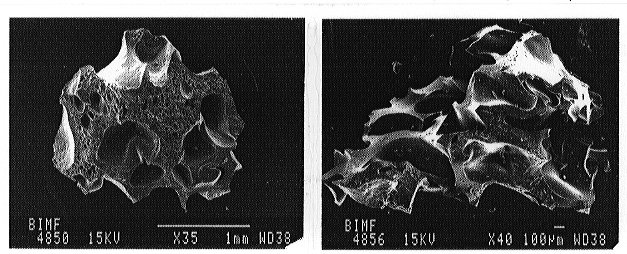

Magma fragmentation may occur either in the volcanic conduit during magma ascent (leading to plinian columns) or in domes (leading to pyroclastic flows and surges). Although several studies (analytical and numerical calculations, experiments at room pressure and temperature using analogue materials in shock-tube type apparatus) have been performed, the fragmentation mechanisms are poorly understood. However, it is known that the fragmentation process is directly influenced by the magma physical properties and the decompression rate. In order to simulate natural eruption conditions, we are performing systematic experiments up to 950°C and 200 bars in the fragmentation bomb, using materials of different vesicularities and melt water contents. Vesiculation and fragmentation under rapid decompression are achieved in a single experiment, therefore avoiding bubble collapse.
The starting materials are haplogranitic (HPG8-Qz36Ab39Or25) glass cylinders (either 20 mm in diameter, 2.5 cm long or 8 mm in diameter and 2 cm long), hydrated up to 4 wt% in an internally-heated pressure vessel (CNRS-CRSCM, Orléans). Three sets of experiments are being performed, simulating vesiculation + fragmentation processes leading to pyroclastic flows, surges and plinian columns.
- To simulate fragmentation leading to pyroclastic flows (dome collapse or magma decompression by material removal), experiments are being performed in order to reach vesicularities up to 30 vol%, without any water overpressure in bubbles, with the equilibrium between the water in bubbles and the dissolved water in the melt being checked using the gas volume fraction equation. Fragmentation occurs at pressures up to 200 bars, depending on the simulated dome volume.
- Surges start from a growing dome, but an additional factor is required to give such violent fragmentations. We are thus testing the contribution to the fragmentation process of water overpressure in bubbles, due to very high melt viscosities (which could prevent the bubble expansion). The experiments are being performed in order to reach vesicularities up to 30 vol% and melt viscosities above 108 Pa s, which can be reached by extremely low melt water contents and low temperatures. Water overpressure in bubbles is checked by a closed porosity and a higher calculated gas volume fraction than the measured porosity. Fragmentation occurs at pressures below 100 bars.
- To simulate fragmentation leading to plinian eruptions, experiments are being performed in order to reach vesicularities of 60-70 vol% (opened-porosity) and the fragmentation occurs at 200 bars.
Preliminary nucleation experiments have shown that we can control the nucleation
process and define the vesicularity that should be reached before fragmentation.
After vesiculation + fragmentation experiments, the porosity of the fragments
is measured by image analysis, the melt water content is measured either
by infrared spectroscopy or Karl-Fischer titration and the melt viscosity
is calculated. The difference between calculated and measured porosity
gives the water overpressure in the bubbles. These characteristics and
the textural study of the fragments by SEM images (Fig. 3.7-4) allow to
define the fragmentation mechanisms (Annual Report 1996).
 |
|

Tel: +49-(0) 921 55 3700 / 3766, Fax: +49-(0) 921 55 3769, E-mail: bayerisches.geoinstitut(at)uni-bayreuth.de
 Previous page
Previous page